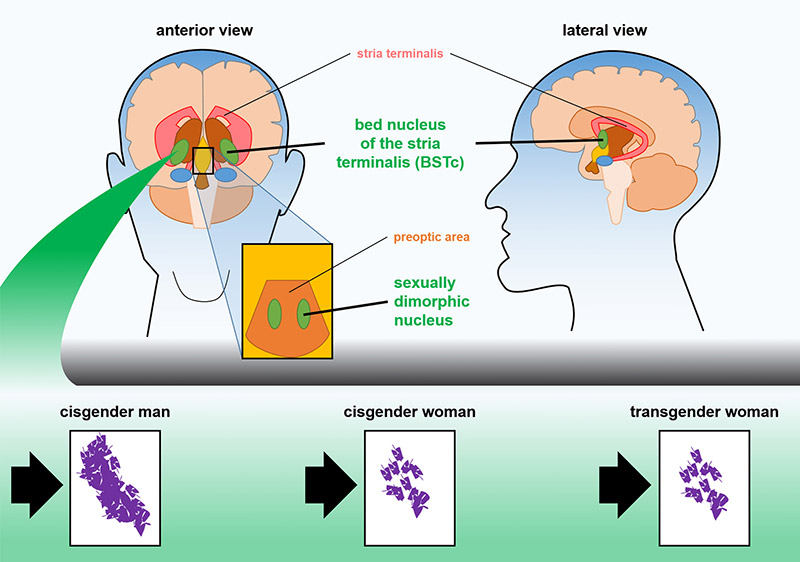Understanding our brain
Transgender identity is complex and unlikely ever to be attributed to one set of causes. Research into the science of transgender identity is relatively new, but existing studies point toward some biological basis. One promising area of research has been in the field of neuroscience. Researchers are exploring ways in which the brain structure and function of transgender persons seems to align more with their gender identities than with sex assigned at birth.
The image below shows the findings of some of the research on brain structure and gender identity. Notice how the part in purple shows that an area of the brain in a transgender woman looks more like that of a cisgender woman than a cisgender man.

This interesting finding has been replicated in multiple studies. As scientists continue to explore these and other clinical data, the science of gender identity will be better understood.
Featured Content
Read this article from the Cleveland Clinic to learn about current scientific research into transgender identities, including emerging evidence relating to nonbinary identities.
References:
Bakker, J. (2018) Brain structure and function in gender dysphoria. Presented at the 20th European Congress of Endocrinology. Endocrine Abstracts, 56(S 30.3). https://www.endocrine-abstracts.org/ea/0056/ea0056s30.3.htm
Bodkin, H. (2018, May 22). Transgender brain scans promised as study shows structural differences in people with gender dysphoria. Telegraph. https://www.telegraph.co.uk/news/2018/05/22/transgender-brain-scans-promised-study-shows-structural-differences/?WT.mc_id=tmg_share_fb
Cleveland Clinic. (2019, March 27). Research on the Transgender Brain: What You Should Know. health essentials. https://health.clevelandclinic.org/research-on-the-transgender-brain-what-you-should-know/
Garcia-Falgueras, A. & Swaab, D.F. (2008). A sex difference in the hypothalamic uncinate nucleus: relationship to gender identity. Brain: A Journal of Neurology, 131(12), 3132-3146. https://academic.oup.com/brain/article/131/12/3132/295849/A-sex-difference-in-the-hypothalamic-uncin...
Wu, K.J. (2016, October 25). Between the (gender) lines: The science of transgender identity. Science in the News. http://sitn.hms.harvard.edu/flash/2016/gender-lines-science-transgender-identity/
Dee
Who is Dee?
Gender Identity
 Our core sense of who we are as a man, a woman, a mixture of both, or neither.
Our core sense of who we are as a man, a woman, a mixture of both, or neither.
Gender Expression
 How we show up in the world through choices like clothing, hair style, mannerisms or tone of voice.
How we show up in the world through choices like clothing, hair style, mannerisms or tone of voice.
Attraction
 How we feel toward others sexually, romantically and/or emotionally.
How we feel toward others sexually, romantically and/or emotionally.
Biological Sex
 Physical attributes such as reproductive organs and genitalia, chromosomes, genes and hormone levels.
Physical attributes such as reproductive organs and genitalia, chromosomes, genes and hormone levels.
Explore More
Read this detailed academic paper to understand the neuroscientists' research of the brain of transgender and cisgender people.
Curious to learn more about the research on brain structure and neurological patterns, as it relates to transgender identity? Read a summary of a forthcoming article by the scientists conducting this cutting-edge research.
